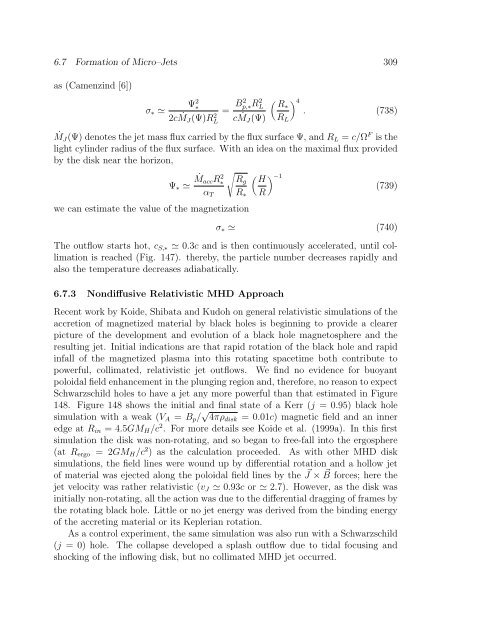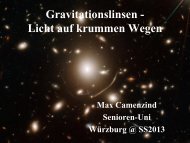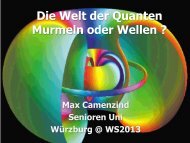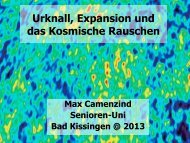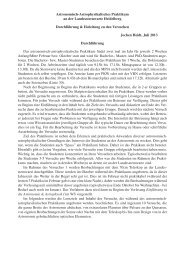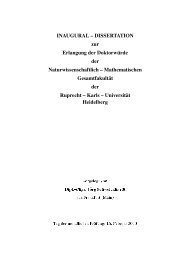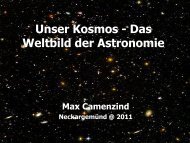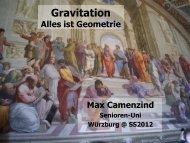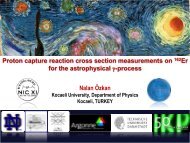Contents List of Figures
Contents List of Figures
Contents List of Figures
You also want an ePaper? Increase the reach of your titles
YUMPU automatically turns print PDFs into web optimized ePapers that Google loves.
6.7 Formation <strong>of</strong> Micro–Jets 309<br />
as (Camenzind [6])<br />
σ∗ <br />
Ψ 2 ∗<br />
2c ˙ MJ(Ψ)R 2 L<br />
= B2 p,∗R 2 L<br />
c ˙ MJ(Ψ)<br />
4<br />
R∗<br />
RL<br />
. (738)<br />
˙MJ(Ψ) denotes the jet mass flux carried by the flux surface Ψ, and RL = c/Ω F is the<br />
light cylinder radius <strong>of</strong> the flux surface. With an idea on the maximal flux provided<br />
by the disk near the horizon,<br />
Ψ∗ ˙ MaccR 2 ∗<br />
αT<br />
<br />
Rg<br />
R∗<br />
we can estimate the value <strong>of</strong> the magnetization<br />
−1<br />
H<br />
R<br />
(739)<br />
σ∗ (740)<br />
The outflow starts hot, cS,∗ 0.3c and is then continuously accelerated, until collimation<br />
is reached (Fig. 147). thereby, the particle number decreases rapidly and<br />
also the temperature decreases adiabatically.<br />
6.7.3 Nondiffusive Relativistic MHD Approach<br />
Recent work by Koide, Shibata and Kudoh on general relativistic simulations <strong>of</strong> the<br />
accretion <strong>of</strong> magnetized material by black holes is beginning to provide a clearer<br />
picture <strong>of</strong> the development and evolution <strong>of</strong> a black hole magnetosphere and the<br />
resulting jet. Initial indications are that rapid rotation <strong>of</strong> the black hole and rapid<br />
infall <strong>of</strong> the magnetized plasma into this rotating spacetime both contribute to<br />
powerful, collimated, relativistic jet outflows. We find no evidence for buoyant<br />
poloidal field enhancement in the plunging region and, therefore, no reason to expect<br />
Schwarzschild holes to have a jet any more powerful than that estimated in Figure<br />
148. Figure 148 shows the initial and final state <strong>of</strong> a Kerr (j = 0.95) black hole<br />
simulation with a weak (VA = Bp/ √ 4πρdisk = 0.01c) magnetic field and an inner<br />
edge at Rin = 4.5GMH/c 2 . For more details see Koide et al. (1999a). In this first<br />
simulation the disk was non-rotating, and so began to free-fall into the ergosphere<br />
(at Rergo = 2GMH/c 2 ) as the calculation proceeded. As with other MHD disk<br />
simulations, the field lines were wound up by differential rotation and a hollow jet<br />
<strong>of</strong> material was ejected along the poloidal field lines by the J × B forces; here the<br />
jet velocity was rather relativistic (vJ 0.93c or 2.7). However, as the disk was<br />
initially non-rotating, all the action was due to the differential dragging <strong>of</strong> frames by<br />
the rotating black hole. Little or no jet energy was derived from the binding energy<br />
<strong>of</strong> the accreting material or its Keplerian rotation.<br />
As a control experiment, the same simulation was also run with a Schwarzschild<br />
(j = 0) hole. The collapse developed a splash outflow due to tidal focusing and<br />
shocking <strong>of</strong> the inflowing disk, but no collimated MHD jet occurred.


